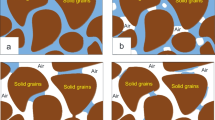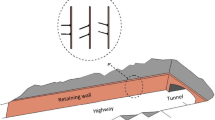Abstract
Metro shield tunnels under the lateral relaxation of soil (LRS) are susceptible to significant lateral deformations, which jeopardizes the structural safety and waterproofing. However, deformation control standards for such situations have not been clearly defined. Therefore, based on a specific case, a model test is conducted to realize the LRS of a shield tunnel in a sandy stratum to reveal its effect on segment liners. Subsequently, a deformation control criterion is established. The LRS is simulated by linearly reducing the loads applied to the lateral sides of the segment structure. During lateral unloading, the lateral earth pressure coefficient on the segment decreases almost exponentially, and the structural deformation is characterized by horizontal expansion at the arch haunches and vertical shrinkage at the arch vault and arch bottom. Based on the mechanical pattern of the segment structure and the acoustic emission, the deformation response of a segment can be classified into three stages: elastic and quasi-elastic, damage, and rapid deformation development. For a shield tunnel with a diameter of approximately 6 m and under the lateral relaxation of sandy soil, when the ellipticity of the segment is less than 2.71%, reinforcement measures are not required. However, the segment deformation must be controlled when the ellipticity is 2.71% to 3.12%; in this regard, an ellipticity of 3% can be used as a benchmark in similar engineering projects.
Similar content being viewed by others
References
Liu X, Bai Y, Yuan Y, Mang H A. Experimental investigation of the ultimate bearing capacity of continuously jointed segmental tunnel linings. Structure and Infrastructure Engineering, 2016, 12(10): 1364–1379
Zhang Z, Huang M, Wang W. Evaluation of deformation response for adjacent tunnels due to soil unloading in excavation engineering. Tunnelling and Underground Space Technology, 2013, 38: 244–253
Chen R P, Meng F Y, Li Z C, Ye Y H, Ye J N. Investigation of response of metro tunnels due to adjacent large excavation and protective measures in soft soils. Tunnelling and Underground Space Technology, 2016, 58: 224–235
Liang R Z, Wu W B, Yu F, Jiang G S, Liu J W. Simplified method for evaluating shield tunnel deformation due to adjacent excavation. Tunnelling and Underground Space Technology, 2018, 71: 94–105
Sharma J S, Hefny A M, Zhao J, Chan C W. Effect of large excavation on deformation of adjacent MRT tunnels. Tunnelling and Underground Space Technology, 2001, 16(2): 93–98
Liang R Z, Xia T D, Huang M S, Lin C G. Simplified analytical method for evaluating the effects of adjacent excavation on shield tunnel considering the shearing effect. Computers and Geotechnics, 2017, 81: 167–187
Huang X, Schweiger H F, Huang H W. Influence of deep excavations on nearby existing tunnels. International Journal of Geomechanics, 2013, 13(2): 170–180
Zheng G X, Yang H, Zhou Y, Du J, Sun X Y, Yu X. A simplified prediction method for evaluating tunnel displacement induced by laterally adjacent excavations. Computers and Geotechnics, 2018, 95: 119–128
Wu H N, Shen S L, Liao S M, Yin Z Y. Longitudinal structural modelling of shield tunnels considering shearing dislocation between segmental rings. Tunnelling and Underground Space Technology, 2015, 50: 317–323
Wu H N, Shen S L, Yang J, Zhou A N. Soil-tunnel interaction modelling for shield tunnels considering shearing dislocation in longitudinal joints. Tunnelling and Underground Space Technology, 2018, 78: 168–177
Shi C H, Cao C Y, Lei M F, Peng L M, Ai H J. Effects of lateral unloading on the mechanical and deformation performance of shield tunnel segment joints. Tunnelling and Underground Space Technology, 2016, 51: 175–188
Mitchell J K, Soga K. Fundamentals of Soil Behavior. 4th ed. New Jersey: Wiley, 2005
Xia M Y, Sun Y M. Law of consolidation creep ctrain and stress relaxation in saturated soft clay. Journal of Tongji University, 1996, 17(3): 319–327 (in Chinese)
Lade P V, Nam J, Liggio C D Jr. Effects of particle crushing in stress drop-relaxation experiments on crushed coral sand. Journal of Geotechnical and Geoenvironmental Engineering, 2010, 136(3): 500–509
Lade P V, Karimpour H. Stress relaxation behavior in Virginia Beach sand. Canadian Geotechnical Journal, 2015, 52(7): 813–835
Yin Z Y, Zhang D M, Hicher P, Huang H W. Modelling of time-dependent behaviour of soft soils using simple elasto-viscoplastic model. Chinese Journal of Geotechnical Engineering, 2008, 30(6): 880–888
Tong F, Yin J H. Experimental and constitutive modeling of relaxation behaviors of three clayey soils. Journal of Geotechnical and Geoenvironmental Engineering, 2013, 139(11): 1973–1981
Wang J F, Xia Z Q. DEM study of creep and stress relaxation behaviors of dense sand. Computers and Geotechnics, 2021, 134: 104142
Xu M, Hong J T, Song E X. DEM study on the macro- and micro-responses of granular materials subjected to creep and stress relaxation. Computers and Geotechnics, 2018, 102: 111–124
Yao B B, Ma H H. Stress relaxation test and constitutive equation of saturated soft soil. Journal of Highway and Transportation Research and Development, 2011, 28(7): 14–18 (in Chinese)
Tian G F, Tang L S. Lateral stress relaxation of soil under confined compression condition. Rock and Soil Mechanics, 2012, 33(3): 783–787 (in Chinese)
Zhang D M, Xie X C, Li Z L, Zhang J. Simplified analysis method for predicting the influence of deep excavation on existing tunnels. Computers and Geotechnics, 2020, 121: 103477
Yang P, Song L, Xue S B, Jiang T. State-of-the-art of the stress relaxation tests and constitutive model research. Soil and Engineering & Foundation, 2017, 31(2): 206–210 (in Chinese)
González C, Sagaseta C. Patterns of soil deformations around tunnels: Application to the extension of Madrid Metro. Computers and Geotechnics, 2001, 28(6–7): 445–468
Zhang D M, Zou W B, Yan J Y. Effective control of large transverse deformation of shield tunnels using grouting in soft deposits. Chinese Journal of Geotechnical Engineering, 2014, 36(12): 2204–2212 (in Chinese)
Shen S L, Wu H N, Cui Y J, Yin Z Y. Long-term settlement behaviour of metro tunnels in the soft deposits of Shanghai. Tunnelling and Underground Space Technology, 2014, 40: 309–323
Zhang D M, Huang Z K, Wang R L, Yan J Y, Zhang J. Grouting-based treatment of tunnel settlement: practice in Shanghai. Tunnelling and Underground Space Technology, 2018, 80: 181–196
Wang S M, Ruan L, Shen X Z, Dong W J. Investigation of the mechanical properties of double lining structure of shield tunnel with different joint surface. Tunnelling and Underground Space Technology, 2019, 90: 404–419
Liu C K, Wang S M, Guo W Q, Chen F, Zhang J B, He C. Investigation of the deformation characteristics and bearing capacity of a segment structure of a shield tunnel with cracks. KSCE Journal of Civil Engineering, 2022, 26(1): 381–393
GB50010-2010. Code for Design of Concrete Structures. Beijing: Ministry of Construction of the PRC, 2010 (in Chinese)
Wang S M, Yu Q Y, Peng B, Xu G W. Model test study on progressive failure mechanism of segment lining structure of underwater shield tunnel. China Civil Engineering Journal, 2016, 49(4): 111–120 (in Chinese)
Feng K, He C, Qiu L, Zhang L, Wang W, Xie H M, Zhang Y Y, Cao S Y. Full-scale tests on bending behavior of segmental joints for large underwater shield tunnels. Tunnelling and Underground Space Technology, 2018, 75: 100–116
Xu G W, Wang S M, Dai G H, An Z L. Research on the circumferential simulation method of shield tunnel joints based on internal and external division slotting. Journal of the China Railway Society, 2016, 38(4): 90–97 (in Chinese)
Chen J S, Mo H H. Numerical study on crack problems in segments of shield tunnel using finite element method. Tunnelling and Underground Space Technology, 2009, 24(1): 91–102
He C, Zhang J G, Su Z X. Structural Mechanical Properties of Large-section Underwater Shield Tunnels. 1st ed. Beijing: Science Press, 2010 (in Chinese)
Ye F, Gou C F, Sun H D, Liu Y P, Xia Y X, Zhou Z. Model test study on effective ratio of segment transverse bending rigidity of shield tunnel. Tunnelling and Underground Space Technology, 2014, 41: 193–205
Wang R L. Analysis of deformation influencing factors and deformation characteristics of soft ground railway tunnels in Shanghai. Underground Engineering and Tunnels, 2009, 1: 1–7 (in Chinese)
Zhao H L, Liu X, Bao Y H, Yuan Y, Bai Y. Simplified nonlinear simulation of shield tunnel lining reinforced by epoxy bonded steel plates. Tunnelling and Underground Space Technology, 2016, 51: 362–371
Acknowledgements
This study was supported by the National Natural Science Foundation of China (Grant Nos. 52178398, 51991394, and 51278424).
Author information
Authors and Affiliations
Corresponding author
Rights and permissions
About this article
Cite this article
Wang, S., Peng, X., Zhou, H. et al. Deformation control criterion of shield tunnel under lateral relaxation of soft soil. Front. Struct. Civ. Eng. 17, 780–795 (2023). https://doi.org/10.1007/s11709-023-0944-3
Received:
Accepted:
Published:
Issue Date:
DOI: https://doi.org/10.1007/s11709-023-0944-3




